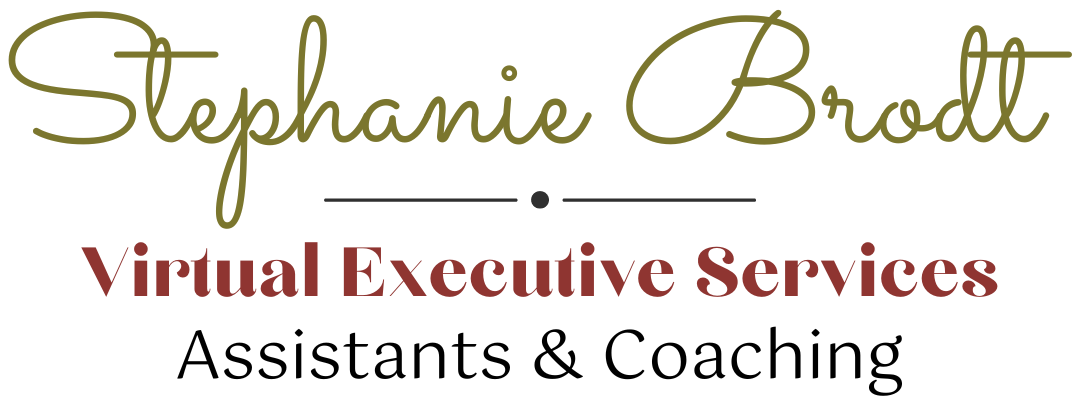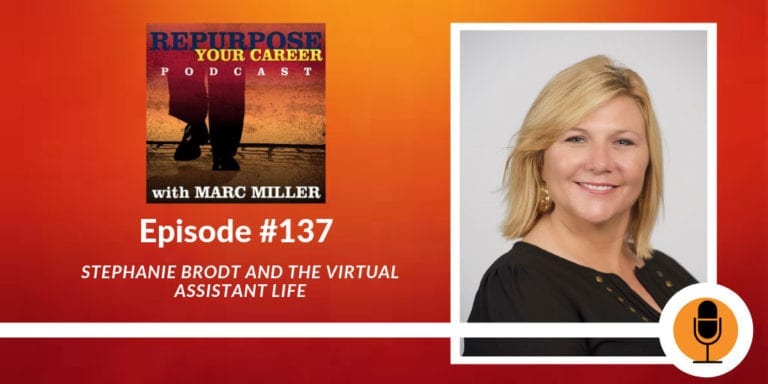Originally posted on the CareerPivot blog; updated June 2020.
In this episode, I am interviewed by Marc Miller of Career Pivot on how I became a virtual assistant. I love helping other women pursue the lives they want to live, and this podcast episode was a fun and different way to share my story!
You can check out Marc’s show notes and the podcast itself below.
Check out the podcast on this page:
[1:29] Marc welcomes you to Episode 137 of the Repurpose Your Career podcast. Career Pivot is the sponsor of this podcast; CareerPivot.com is one of the very few websites dedicated to those of us in the second half of life and our careers. Check out the blog and the other resources delivered to you, free of charge.
[3:32] Marc had planned on playing Mark’s interview this week but changed his mind. This week, Marc is interviewing Stephanie Brodt. Marc shares her biography.
[4:43] Marc welcomes Stephanie to the Repurpose Your Career podcast. Stephanie is Marc’s virtual assistant (VA) and she is launching a new course on how to become a VA. Many Baby Boomers have never considered becoming a VA.
[5:16] Stephanie has already talked to Marc’s online membership community, so Marc wanted to bring her onto the podcast, too, to explain what a VA does. Stephanie is not a Boomer but is near the upper end of Generation X.
[5:59] Stephanie started out of college as a receptionist for the Columbus Symphony Orchestra.
[6:010] Her bachelor’s degree is in business management, but she always worked in the office as an executive assistant, administrative assistant, project manager, and general manager, all basically in positions where she assisted other people to be successful. Stephanie liked being behind the scenes, managing the details of projects.
[6:36] Stephanie loves that work and has done it for 20-plus years for different organizations, mainly at institutions of higher education.
[6:51] Today Stephanie works virtually, from her home office or while traveling with her husband. She works as a VA, which has slowly gone into coaching other people how to take their office skills and use them virtually instead of at a physical location. She started by coaching her friends who were interested in working virtually.
[7:31] Stephanie still keeps a few clients on hand that she works for as a VA, mixed in with the coaching.
[7:44] A virtual assistant assists in whatever that business is doing, just as in an office — help your boss manage calendars, send out newsletters, help them with correspondence and customers. You may help them with data, bookkeeping, or accounting. Whatever you can do to assist them, you can do virtually, online.
[8:22] Small business owners and medium-sized business owners may need help and not have a full-time employee to help them. A virtual assistant could do website management or blog editing. They could edit books. It could be anything that a company needs.
[9:04] Stephanie edits Marc’s blogs, sends emails, puts together Marc’s podcast, and sometimes talks to Marc’s clients. Marc put a request on LinkedIn that he was looking for a VA and Stephanie responded to it. When they first connected, Stephanie was living in Indiana. Now, she lives in Florida, where she and her husband moved to “semi-retire.”
[10:01] Marc and Stephanie have never met in person. That is how things are with most of her clients. Stephanie has had clients in Spain, the UK, Australia, and one in Colorado, U.S. Stephanie and Marc do video conferences online.
[10:44] It was a slow process for Stephanie to go from the workplace to the virtual workplace. The more she did her job, the better she knew it. The older she got, the more freedom she wanted to have. She wanted to schedule her own time off.
[11:22] When Stephanie was brought into her final corporate job, the company had no administrative staff and she was asked to create one. Stephanie brought on three assistants and taught them how to run an administrative team. As they became better, Stephanie was eventually told that the team could work without her and she was let go.
[11:58] Stephanie was sad that the position was gone, but in the back of her mind, she didn’t want to return to an office where she had to beg for her time off. She didn’t enjoy the commute or the time clock. She started looking for ways not to go back to an office. They had given her a severance amount, so she had a little cushion.
[12:57] Stephanie and her husband agreed that she could use up the cushion, and if she hadn’t figured out what to do after that, she would go back to an office. They cut back wherever they could and Stephanie started figuring it out.
[13:17] Stephanie’s job was to spend 40 hours a week figuring out what she could do. What she figured out was that she could do what she had always done: the tasks she had always done in an office. She could quickly convert that to working online for clients all around the world and work when she wanted.
[13:58] She could work at home or while they traveled in the car. She could hook up her phone as a hotspot and work in the car as they drove from Indiana to Florida. Her clients never noticed it. She didn’t have to ask anyone for anything. She could just do it.
[14:21] The more Stephanie found out, the more she started doing it, the more passionate she became. People her age that have always known work in a physical location had no idea this work was available and how easy it is to step into it.
[14:44] Stephanie became very adamant about telling people around her when they would ask about it, that they could use their computer at home the same way they use it in an office, with just a few tricks and connecting programs added.
[15:07] When she saw people being suffocated by the time and place restrictions of work, she was passionate about helping them do the same things she was doing. Besides coaching people how to be VAs, she keeps a few clients that she really enjoys working for herself, Marc being one of them.
[15:49] Stephanie eventually chose a specific niche for her VA work. At first, Stephanie worked for companies that were in areas she had already worked in. She recommends staying in familiar territory to start. Once, she picked up a client who was an author and a life coach.
[16:27] This client was producing things for her clients that resonated with Stephanie. Stephanie was so interested, she would have assisted this client for free. That led her to see that she enjoys that type of work more. Working on her terms allowed her to discover and choose what she liked best.
[17:10] Stephanie started to look toward people who were authors, speakers, and life coaches, to study their mentality and way of looking at life. She started looking only for that type of work. She might take on others that approached her or hire assistants to do the work for those clients. This started unexpectedly, from all the referrals she received.
[18:06] To avoid disappointing the people who had sent her the referrals, Stephanie brought on assistants she managed and assured the quality of their work. Stephanie retains for herself the work for coaches, speakers, and authors.
[18:33] Marc describes VA work to his clients like this: You work 80% of the time, you make 75% of what you used to make, and you get to fire clients you don’t like.
[19:08] Stephanie wants to really live every day, not just weekends, vacations, or holidays. She goes to lunch with friends, and does the work in a morning, evening or the next day. She also only picks clients she enjoys working with and who click with her.
[20:04] You set up your business in a way that you do get to choose. Don’t set up your business in a way that money is so tight you have to take every client, whether you work well together or not.
[20:40] There are certain clients that are going to make you miserable but you get to make that choice.
[20:53] Stephanie first thought that she would just do the work that she knew how to do and it would be very easy, and relaxing. She thought she wouldn’t have to work as hard.
[21:12] Stephanie feels like she has put more energy into it than she thought she would but she’s passionate about what she does. The hours and the days seem to fly by. She’s not watching a clock. Her work blends easily with her life.
[21:35] Stephanie sets limits to her work time. She has family time and she meets a friend every week for a long lunch. But she doesn’t forget her work at the end of the day She’s always thinking of what she can make better and what she can do next. She looks forward to the challenges every day. It’s much more than just a job; it’s a real part of her.
[22:55] Stephanie talks about the online course she is launching. She found that a lot of people her age who have worked in an office for many years have a lot of fears and doubts about working at home or wherever they want to work. They don’t understand how that plays together.
[23:30] Stephanie created a very simple course and teaches it the way she wishes someone had taught her, on how to take what you do right now and how to go find clients that want to hire you for those skills.
[23:46] In her course, Stephanie walks you through how to write emails to prospective clients showing what you can do for them, how to follow up with those prospects, and how to create your profiles online so that someone looking for a VA or a project manager will see you and be drawn to you.
[24:08] Stephanie teaches the very basic steps that get you from beginning to end as far as finding the clients and getting the money coming in. That’s a big fear if you’ve had 20 years in an office with good pay, benefits, and security. To walk away from all of that is a scary, scary thing.
[24:35] If you have a job now, you can start working through this course on the side and bringing on a few clients. You will charge more per hour than you were paid in an office, keeping in mind that you have to pay for your insurance. When you have enough clients on the side, you can seamlessly walk over and go on your own.
[25:06] This course teaches you how to do that. You don’t buy a lot of equipment, you don’t have to create a website, and you don’t have to put all this money into a business. To start, you just take what you know and you start telling other people about it and helping them out, and they pay you for it. It’s as easy as that.
[25:31] Stephanie sells the course to do at your own pace when you want. Stephanie also does a private Facebook group for questions and answers in Live Q&As with her. It’s a hand-holding process for how to get started until you’re ready to leave the office.
[25:51] Marc refers back to Episode 14 with Taylor Pearson, the author of The End of Jobs: Money, Meaning and Freedom Without the 9-to-5. Taylor Pearson calls this process stair-stepping your way out.
[26:21] You can do as Stephanie did, having a little cushion to support her at first, or you can build it up on the side until you are confident in going on your own full-time. Stephanie is confident that if you have used those skills in the corporate world for several years, you can use them successfully in your own online business.
[26:43] Companies are craving people who have done the work, who know how to show up and hit deadlines. It’s hard to find that type of person. They need you. Stephanie wants to teach people how to get out there and do it.
[27:05] Administrative assistant jobs in big corporations are going away but the work isn’t going away. To solopreneurs, independent contractors, and small service firms who don’t want to hire a full-time employee, this makes perfect sense.
[27:34] The waitlist for Stephanie’s course can be found here. You can reach out to Stephanie by phone or email on her website.
[29:06] Virtual Assistants are a relatively new concept in the last 10 years or so. Marc tells how he uses Stephanie’s services. Because Marc gives deadlines to Stephanie, it forces him to get things on time to her.
[30:17] Marc thanks Stephanie for being on the Repurpose Your Career podcast.
[30:26] Marc hopes you enjoyed this episode. Being a virtual assistant is one of the ways you can gain freedom from the ‘nine-to-five grind.’ Stephanie enjoys both the job and the freedom it allows her to pursue her life dream.
[32:10] You will find the show notes for this episode at CareerPivot.com/episode-137.


